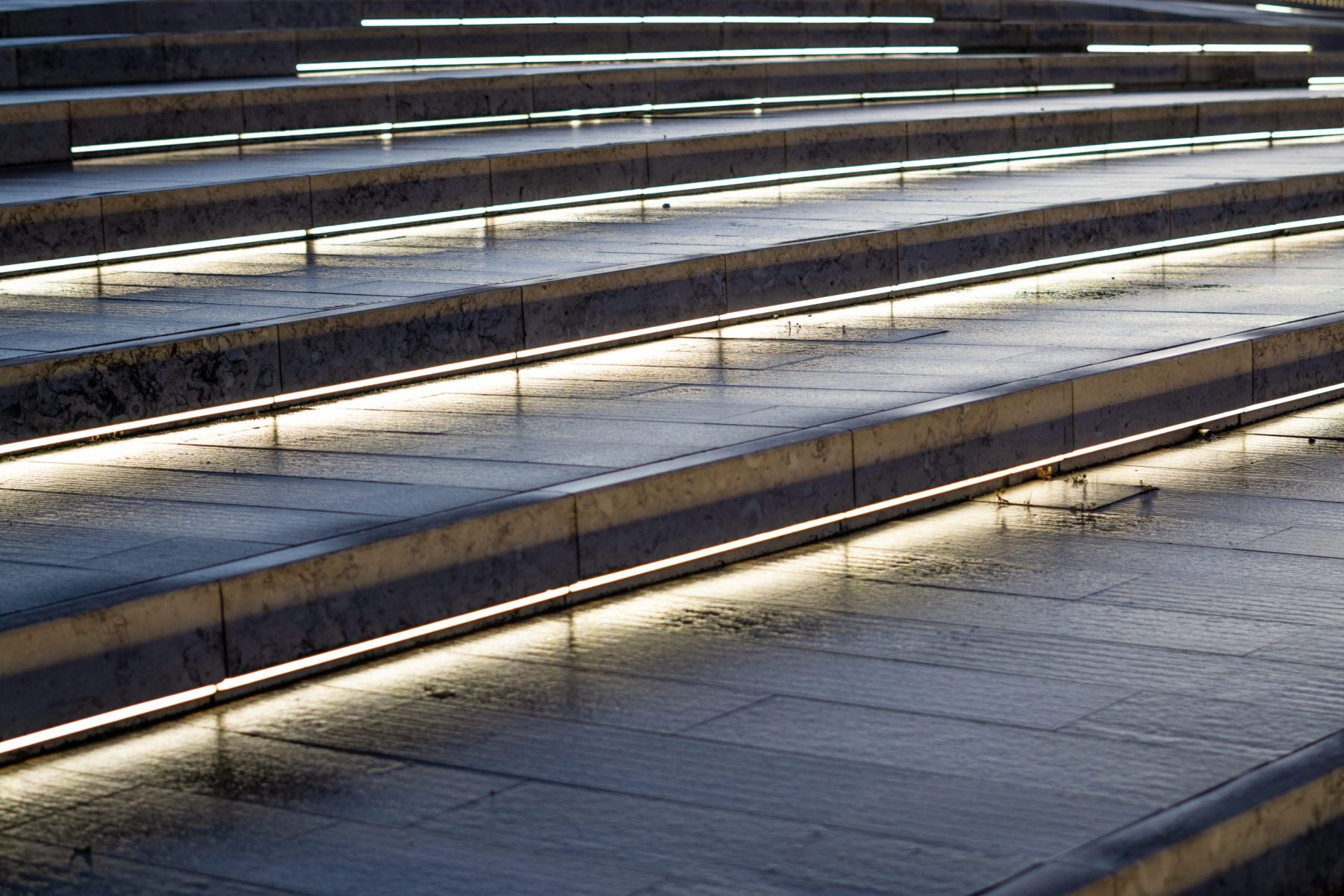At DFL, we often get asked about the difference between architectural and public realm lighting. For us, the answer’s simple…
Architectural lighting involves illuminating a building, structure or property to accentuate its features. On the other hand, public realm lighting is about using light to improve the accessibility and ambience of built environments — covering more ground (literally and figuratively) than the former lighting type.
As a lighting consultancy that believes lighting designs should work in harmony to emphasise the visual appeal of buildings and elevate the areas that surround them, we’ve got a pretty good understanding of the factors that set these two approaches apart — and which way to go for the best results.
Want to know more? Your wish is our command…
1. Scope and scale vary between the two
The most obvious difference between architectural and public realm lighting is how much is being lit.
Usually, architectural lighting designs will focus on lighting up the key features on the building at hand. For example, a few spotlights might be used to highlight accents like stain glass windows and alcoves on places like churches, museums and heritage sites.
In contrast, the sky’s the limit when it comes to the scope and scale of public realm lighting projects, which are concerned with various aspects of outdoor spaces. For example, these schemes might use cluster lights or strips to brighten up anything that’s used or seen by pedestrians, cyclists, drivers and residents, like forecourts, pathways and plants.
2. They don’t seek to serve the same purpose
To say the point of architectural and public realm lighting designs are different would be an understatement.
As architectural lighting designs are concerned with how buildings look, these schemes might use creative assets like floodlights to send a wash of illumination over a building’s façade and ensure it has as much (if not more) of a visual impact at night as it does in the day.
Unsurprisingly, that’s not the case for public realm projects. Whilst aesthetics play an important part in these types of lighting schemes, they do only play a part. Public realm lighting also involves ensuring pedestrians have visibility over key access routes for wayfinding and safety purposes, meaning ultra-bright assets that could cause light spill, glare and visual discomfort are a no-go.
3. Their functionality requirements aren’t the same
It’s not just where and why the lights architectural and public realm lighting use that differ, it’s also how these lights function.
With architectural lighting schemes, assets boasting artistic or decorative functions are key to creating dramatic visual effects that suit the time of year or event. For instance, colour-changing LEDs can be set to vivid reds and greens to show a building’s festive spirit at Christmas.
These same colour-changing lights can also feature public realm lighting designs, such as in fountains, but not if they interfere with accessibility. On areas like pathways and steps, lights with an adjustable output function may be used instead — their brightness can be increased to ensure pedestrians can see where they’re going from dusk ‘til dawn.
4. One’s got to be inclusive, one doesn’t
Whilst architectural lighting illuminates building exteriors that people see, public realm lighting brightens up the spaces people use. Thus, they have very different approaches to inclusivity.
Architectural lighting schemes might avoid design features known to cause problems for those with a sensitivity to light, such as flashing lights or assets with strobe effects that can trigger seizures in epileptic onlookers and distress autistic passers-by. But that’s typically about it.
However, needing to be as practical as they are decorative, public realm lighting schemes treat catering peoples’ diverse needs as a top priority. So, these designs will follow guidance from the likes of BS8300-1:2018 to ensure inclusivity — avoiding glare, which can worsen visual impairments, by adopting solutions like louvers and clearly lighting steps, stairs and wheelchair ramps.
5. The environment isn’t equally important to both
Every new lighting installation must consider sustainability nowadays. Still, some treat eco-friendliness as a secondary concern, whilst others hold it as highly as aesthetics and practicality.
Because architectural lighting schemes only have one box to tick — visual appeal — they don’t need to factor in things like energy consumption. In turn, the assets that achieve the most aesthetically pleasing results are bound to be chosen over ones that are less damaging to the planet.
Meanwhile, as public realm lighting is all about improving outside spaces both aesthetically and practically, eco-friendly solutions that help towns and cities reach their sustainability targets and support a more sustainable future are often the default, whether that’s super-efficient LEDs or even solar-powered assets. And with the right lighting design, they can still look the part, too.
So, which one’s better?
There’s no denying that architectural lighting can be an effective way to shine a light on impressive buildings and structures (pardon the pun).
We just think that you can do this and more with public realm lighting, which can improve an entire built environment across the board — resulting in safe, inviting and user-friendly spaces that local communities will love.
So, if you want our advice, go big or go home! Invest in a comprehensive public realm lighting design that tackles a range of important factors all together. We know it might sound daunting, but you could have your dream scheme in no time with the help of our experts…
Learn all about our public realm lighting service and get in touch today; just call +44 (0)1962 855050, email info@dfl-uk.com or complete our contact form.























